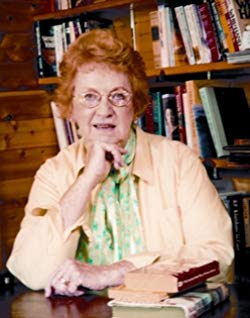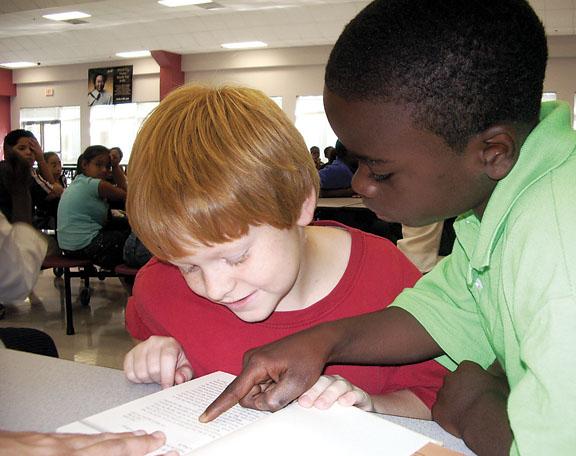Editor’s Note: In our Honey for a Child’s Heart Read-Along this month, we’re considering Chapter 15: “First Books for Readers.” Settle in for some good advice about how to judge literary quality.
How to know the best children’s books

Originally published on the Tumblon website, September 22, 2009
Good children’s books are usually written by grownups who are still children inside. They aren’t written down to children or written for children. Children’s authors must be people who haven’t lost their childhood. In the best of circumstances, people should grow old from the outside in, not from the inside out. Which led C.S. Lewis to say that any book worth reading at ten should be worth reading at fifty! And he wrote those kinds of books. The Narnia Chronicles are evidence of that.
A good book has something of lasting worth; it has a life force that propels children forward. Something creative and imaginative is left behind in the mind of the readers. Such a book captures the permanent stuff of life; it leaves something rich behind.
Remember little children come to us with fresh, uncluttered minds. We get to furnish those blank pages with the ideas, concepts and values as we share with them. Our concern is not to line the shelves of their minds with facts, but with values they can use to build something meaningful of their lives in the days ahead.

This might sound ethereal and abstract to you, but think about it. Most stories are about relationships and the emotions these relationships engender—joy and sorrow, love and hate, admiration or envy, anger and hope. Every child needs to know the possibilities of human feeling, see the consequence of choices and have their hearts stretched by goodness and courage in action. In that sense a good story is capable of inspiring a reader’s inner life. Good stories have a profound morality, not a sentimental kind of sweetness or mushy thinking, but a model for the highest kind of choices and nobility. Great books do not preach; the stuff I am talking about is implicit in the plotting of the story.
That’s why it’s a mistake to buy diluted versions of old stories. They may seem charming, but so often they lack the genius of the original—the spark that made the book special in the first place. Publishers, eager for higher profits, are increasingly taking classics and cheapening them, driven by sales, rather than artistry. But this is a subject for another blog.
When the language is uninspired and trite readers are the losers. If we want children to speak and to write good language, they need to hear beautiful language in their stories—the right word in the right place. We want them to meet memorable characters like Wilbur and Charlotte when they are younger and characters like Sam Gamgee and Frodo when they are older.
How do we decide what makes a good book? We’ve already looked at how difficult it is to cull out of best from the good. Of first importance is the idea behind the book. What is the author trying to say? A weak theme presents a flabby story. It’s always good to ask, What is this story saying? What is the point?
To get across the theme, the writer must use language. Every writer forms sentences differently and thus weaves a distinct personality into the writing. Word choices are critical because they carry the action, the emotion and the truth of the story. Good prose is like music. The sentences have a rhythm.
Good plots grow out of strong themes. The characters make the plot work. Plot does not answer what happens next ? It answers why? Characters must be memorable. They must be convincing.
What we are talking about is hard work! It’s no easy thing to write a good story. It takes a kind of giftedness –and perseverance. Most great stories take a long time developing before they are born.
Children can’t define what charms them—and maybe you can’t either. But somehow you know. Give children the right thing and they recognize it. They will have little use for what is shallow, insipid, labored or overly moralistic. Not everything they read will be excellent, but they will know a story’s possibilities. That’s why I urge you to read and read what is known to be the best. Acquaintance with many good books helps us weed out what is of lesser value. You are being trained in discernment without knowing it.
© Gladys M. Hunt 2008-10, reissued in 2022 with minor adjustments with permission of the Executor of the Literary Estate of Gladys M. Hunt (4194 Hilton SE, Lowell, MI 49331). Used by permission. All rights reserved.
Support our writers and help keep Redeemed Reader ad-free by joining the Redeemed Reader Fellowship.
Stay Up to Date!
Get the information you need to make wise choices about books for your children and teens.
Our weekly newsletter includes our latest reviews, related links from around the web, a featured book list, book trivia, and more. We never sell your information. You may unsubscribe at any time.
We'd love to hear from you!
Our comments are now limited to our members (both Silver and Golden Key). Members, you just need to log in with your normal log-in credentials!
Not a member yet? You can join the Silver Key ($2.99/month) for a free 2-week trial. Cancel at any time. Find out more about membership here.

